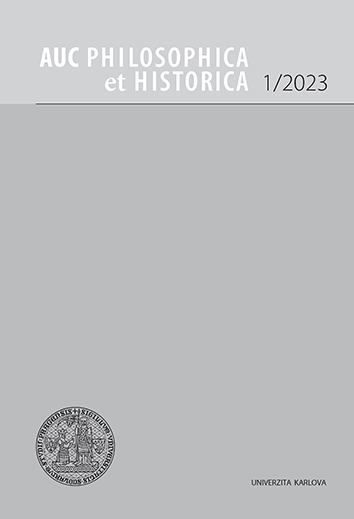AUC Philosophica et Historica je víceoborový akademický časopis zaměřený na humanitní a společenskovědné obory (filozofie, psychologie, pedagogika, sociologie, obecné, české a hospodářské dějiny, pomocné vědy historické a archivnictví, etnologie).
Časopis je indexován v databázích CEEOL, DOAJ a EBSCO.
AUC PHILOSOPHICA ET HISTORICA, Vol 2020 No 2 (2020), 87–115
„Bildhauer in Stuttgart, sonsten aber aus Prag.“ Ondřej Filip Quitainer jako člen družiny pražských umělců v Ludwigsburgu v letech 1709–1714
[“Bildhauer in Stuttgart, sonsten aber aus Prag.” Andreas Philipp Quitteiner as a member of the group of Prague artists in Ludwigsburg (1709 to 1714)]
Martin Hořák
DOI: https://doi.org/10.14712/24647055.2021.4
zveřejněno: 02. 08. 2021
Abstract
Prague sculptor Andreas Philipp Filip Quitteiner (1679–1729) has not been thoroughly examined to date, including his works in the ducal residence of Ludwigsburg. The paper outlines the circumstances of the sculptor’s departure to Ludwigsburg against the background of a recruiting trip undertaken by architect Johann Friedrich Nette (c. 1672–1714) to Prague in October 1708. The author poses the question of the extent to which Quitteiner’s engagement reflected his position in contemporary Prague sculpture and divides Quitteiner’s work in Ludwigsburg into two periods with a turning point occurring in September 1712, when the artist lost his privileged position. In five subchapters, the author focuses attention on the main sets of the sculptor’s works: garden sculpture, allegorical sculptures of Caritas and Prudentia from the vestibule of the Ordensbau palace wing, decoration of the Fürstenbau main palace building, statues on the balustrade of the court of honour, decoration of the ceremonial staircase in the Riesenbau wing. By analysing the extant works, the author arrives at findings on the sculptor’s sources of inspiration and models. The examined works are also analysed from an iconographic perspective and placed in the context of the ruling representation of Duke Eberhard Ludwig Württemberg (1676–1733).
klíčová slova: Ondřej Filip Quitainer / Andreas Philipp Quitteiner (1679–1729); Ludwigsburg Palace; Johann Friedrich Nette (c. 1672–1714); Prague baroque sculpture; baroque in Württemberg; European baroque sculpture
reference (34)
1. Oldřich J. Blažíček, Sochařství baroku v Čechách, Praha 1958.
2. Gottfried Johann Dlabacž, Böhmische Künstler, Hesperus. Ein Nationalblatt für gebildete Leser 82, Dezember 1813, col. 650-651.
3. Gottfried Johann Dlabacž, Allgemeines historisches Künstlerlexikon für Böhmen und zum Theil auch für Mähren und Schlesien, Band I-III, Prag 1815.
4. Werner Fleischhauer, Schlossmuseum Ludwigsburg, amtlicher Führer, Stuttgart 1958
5. Werner Fleischhauer, Barock im Herzogtum Württemberg, Stuttgart 1958.
6. Jan Holeček, Jakub Auguston, in: Petr Macek - Richard Biegel - Jakub Bachtík (eds), Barokní architektura v Čechách, Praha 2015, s. 376-387.
7. Corinna Höper - Andreas Henning, Das Glück Würtemberks, Zeichnungen und Druckgraphik europäischer Künstler des 18. Jahrhunderts, Stuttgart 2004.
8. Martin Hořák, Dvě generace pražských barokních sochařů. Ondřej Filip a Jan Antonín Quitainerovi, in: Staletá Praha XXVIII, 1/2012, s. 2-30.
9. Martin Hořák, Barokní sochařská dílna Ondřeje Filipa a Jana Antonína Quitainerových, (disertační práce), Ústav pro dějiny uměni FF UK, Praha 2019.
10. Jiří Kaše, Projekt restaurátorské akce. Sochařská výzdoba palácové atiky, č.p. 347/III Vlašská 19, Lobkovický (Přehořovský) palác, Praha 1985.
11. Fritz-Eugen Keller, Die Schlusssteine der Bogen am Erdgeschoss des Zeughauses, in: Hans-Ulrich Kessler (ed.), Andreas Schlüter und das barocke Berlin, Berlin 2014, s. 136-167.
12. Martin Krummholz, Giovanni Battista Alliprandi, in: Petr Macek - Richard Biegel - Jakub Bachtík (eds), Barokní architektura v Čechách, Praha 2015, 181-187, s. 236-248.
13. Dobroslav Líbal (ed.), Stavebně historický průzkum, Palác Přehořovských z Kvasejovic. Malá Strana č.p. 347/III, Praha 1968.
14. Martin Mádl, Umělecká výměna mezi Prahou a Ludwigsburgem, Akademický bulletin Akademie věd České republiky, 2009, č.11, s. 24-25.
15. Publius Ovidius Naso, Proměny, Praha 1969.
16. František Martin Pelzel, Abbildungen böhmischer und mährischer Gelehrten und Künstler II., Prag 1775.
17. Antonín Podlaha, Materiálie k slovníku umělců a uměleckých řemeslníků v Čechách, Památky archeologické XXVII, 1915, s. 160-188.
18. Emanuel Poche - Pavel Preiss, Pražské paláce, Praha 1977.
19. Cesare Ripa, Iconologia per Cesare Ripa Perugino, cavallier di SS Mauritio et Lazaro. Divisa in tre libri. Ampliata dal. sig. cav. Gio. Zaratino, castellini Romano, Venetia 1645.
20. Cesare Ripa, Ikonologie, Praha 2019.
21. Hans-Joachim Scholderer - Kirsten Keidl - Birgit Klee, Ludwigsburg 2004, Altes Corps de Logis, Barockgalerie, Fassaden und Dächer, Garten, Ludwigsburg 2004.
22. Ulrich Schließl, Techniken der Faßmalerei in Barock und Rokoko. …das alles von Bronce gemacht zu sein schiene, Stuttgart 1998.
23. Ulrike Seeger, Vienna, Prague, Paris and Augsburg: The Provisioning of Interior Decoration in the Ludwigsburg Residence, in: Spephan Hoppe - Krista Breitling - Stefan De Jonge (eds), The Interior as an Embodiment of Power, Heidelberg 2018, s. 193-204.
24. Daniel Schulz, Mars, Venus, Bacchus & Co.: Die barocken Groß-Skulpturen des Ludwigsburger Schlosses, Ludwigsburger Geschichtsblätter 64/2010, s. 23-59.
25. Staatliche Schlösser und Gärten Baden-Württemberg (Hrsg.), Schloss Ludwigsburg. Geschichte einer barocken Residenz. Silberburg, Tübingen 2004.
26. Jana Tischerová, Matěj Václav Jäckel. Sochař českého baroka 1655-1738, Praha 2013.
27. Robert Uhland, Eberhard Ludwig, in: Neue Deutsche Biographie (NDB), Band 4, Berlin 1959, s. 237-238.
28. Václav Vančura, Příspěvek k dílu Quitainerů, Umění XXXVII, 1989, s. 128-153.
29. Václav Vančura, Jeroným Kohl, Umění XXXIX, 1991, s. 512-532.
30. Publius Vergilius Maro, Aeneis, Praha 1933.
31. Julia Kloss-Weber, Die Villa Kameke, in: Hans-Ulrich Kessler (ed.), Andreas Schlüter und das barocke Berlin, Berlin 2014, s. 416-435.
32. Karl Weiß, Schloß Ludwigsburg. Baugeschichtliche Abhandlung über die von Johann Friedrich Nette erbauten Teile. Ein Beitrag zur Kunstgeschichte des 18. Jahrhunderts, Stuttgart (Dissertation, Technische Hochschule Stuttgart), Stuttgart 1914.
33. Rudolf Wittkower, Gian Lorenzo Bernini, 3rd. edition, Ithaca-New York 1981.
34. Rudolf Wittkower, Art and Architecture in Italy: 1600-1750, 3rd. revised edition, Harmondsworth-Baltimore - Ringwood 1973.

„Bildhauer in Stuttgart, sonsten aber aus Prag.“ Ondřej Filip Quitainer jako člen družiny pražských umělců v Ludwigsburgu v letech 1709–1714 is licensed under a Creative Commons Attribution 4.0 International License.
